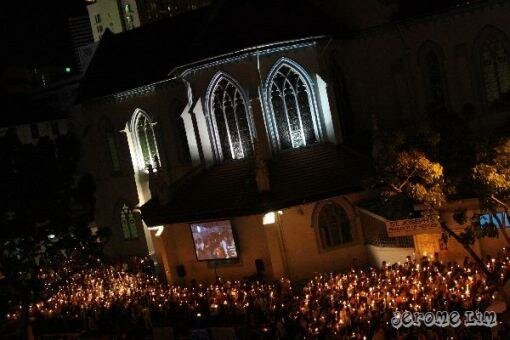Sea of Light
The Good Friday night procession at St Joseph's Church is one of a kind in Singapore.
Once a year during the Good Friday, the compound of St. Joseph’s Church on Victoria Street is transformed into a sea of candlelight, as thousands descend on the church and its compound for the Good Friday procession, spilling over into the area of Queen Street just behind the church. The procession is held to commemorate the crucifixion of Jesus Christ on Good Friday and is part of an evening service where the events leading up to the crucifixion and immediately after the crucifixion of Christ are reenacted.

While the commemoration of the crucifixion of Christ on Good Friday at the church, referred to as the Portuguese Church, may not be as elaborate as the reenactments that take place in the barrio of San Pedro Cutud in the Philippines, during which penitents practice self-flagellation and are nailed literally to the cross, the elaborate manner in which the service and the candlelight procession is conducted is unique in Singapore, with one only other church close by, St. Peter’s Church in Malacca, where a similar (perhaps more elaborate) service is conducted.

During the reenactment of the crucifixion, a life-sized statue depicting the dead Christ is nailed to the cross, following which, the dead Christ is painstakingly lowered to a bier. The bier is then carried out the church into the compound and back into the church, accompanied by a statue depicting Our Lady of Sorrows and much of the clergy and congregation present, where thousands would be gathered in the light of their candles to witness the solemn occasion. The church, having been part of the Portuguese mission administered through the Diocese of the former Portuguese colonies of Goa (up to 1886), and then Macau (up to 1999), (the Catholic churches in Singapore were administered primarily by the French mission and later transferred to the Archdiocese of Singapore), adopted many of the elaborate traditions of the Iberian peninsula (St. Peter’s Church in Malacca was also administered by the Portuguese mission).
As a child, I was a regular and perhaps reluctant participant in the service, having to accompany my maternal grandmother, who made it a point (when she was fit enough) to attend the service. What it meant for me, then a young child, were the hours of play time I would have to give up having to arrive several hours early to be able to get a seat inside the church.
... one of the things I have a lasting memory of was the bunga wangi, as my grandmother would refer to the packet of scented chopped pandan leaves.
Seated on the rattan mesh webbing that were fitted to serve as seats and backrests on the carved wooden pews, with the the statues of the Saints (my favourite was the one of St. Sebastian tied to a stake) high on the church wall that may have otherwise have taken my attention covered in the purple cloth of mourning, there wasn’t much else to do except to wile the hours away poking my fingers through the rattan webbing. The service would culminate in the veneration of the cross, which would follow the procession, and one of the things I have a lasting memory of was the bunga wangi, as my grandmother would refer to the packet of scented chopped pandan leaves – “bunga wangi” meaning “scented flowers” that would be given to each participant after the veneration, which my grandmother would leave under her pillow as soon as she got home.

I was certainly grateful later on in my childhood when my mother allowed me to instead, join her on Queen Street with the thousands holding lighted candles, from where she would stand to witness the procession, while my grandmother attended the service inside the church. Not only did it relieve me of sitting for hours in complete silence, it also released me from the confines of the pews to the street outside, where there certainly was more going on to distract myself. Here, I could watch the candle sellers going about their business, the smaller candles were usually sold in pairs – their wicks attached, and the longer ones supported by a splint, as well as the other goings on around me. I was also able to find amusement with the lighted candle, exchanging light with others and dripping wax onto the ground, on which a mini wax sculpture could be created. It may not sound like much fun, but as a child it was certainly a marked improvement from having to sit quietly and still in the pews!

This post was originally published in The Long and Winding Road in April 2010.

















